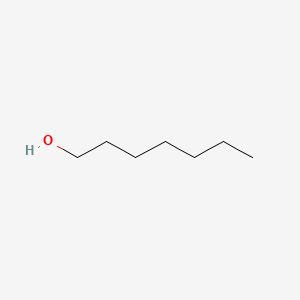| MeSH term | MeSH ID | Detail |
|---|---|---|
| Tachycardia, Ectopic Atrial | D013612 | 1 associated lipids |
| Wounds, Gunshot | D014948 | 2 associated lipids |
| Heart Injuries | D006335 | 6 associated lipids |
| Tachycardia, Ventricular | D017180 | 9 associated lipids |
| Radiation Injuries, Experimental | D011833 | 11 associated lipids |
| Eye Burns | D005126 | 13 associated lipids |
| Cardiomegaly | D006332 | 31 associated lipids |
| Hypertension, Pulmonary | D006976 | 32 associated lipids |
| Ventricular Dysfunction, Left | D018487 | 33 associated lipids |
| Neovascularization, Pathologic | D009389 | 39 associated lipids |
| Arrhythmias, Cardiac | D001145 | 42 associated lipids |
| Occupational Diseases | D009784 | 42 associated lipids |
| Reperfusion Injury | D015427 | 65 associated lipids |
| Diabetes Mellitus, Experimental | D003921 | 85 associated lipids |
| Hypertension | D006973 | 115 associated lipids |
| Adenocarcinoma | D000230 | 166 associated lipids |
n-heptanol
N-heptanol is a lipid of Fatty Acyls (FA) class. N-heptanol is associated with abnormalities such as Corneal Neovascularization. N-heptanol often locates in Epithelium and Structure of corneal epithelium. The related lipids are Heptanol.
Cross Reference
Introduction
To understand associated biological information of n-heptanol, we collected biological information of abnormalities, associated pathways, cellular/molecular locations, biological functions, related genes/proteins, lipids and common seen animal/experimental models with organized paragraphs from literatures.
What diseases are associated with n-heptanol?
n-heptanol is suspected in Corneal Neovascularization and other diseases in descending order of the highest number of associated sentences.
Related references are mostly published in these journals:
| Disease | Cross reference | Weighted score | Related literature |
|---|
Possible diseases from mapped MeSH terms on references
We collected disease MeSH terms mapped to the references associated with n-heptanol
PubChem Associated disorders and diseases
What pathways are associated with n-heptanol
There are no associated biomedical information in the current reference collection.
PubChem Biomolecular Interactions and Pathways
Link to PubChem Biomolecular Interactions and PathwaysWhat cellular locations are associated with n-heptanol?
Visualization in cellular structure
Associated locations are in red color. Not associated locations are in black.
Related references are published most in these journals:
| Location | Cross reference | Weighted score | Related literatures |
|---|
What functions are associated with n-heptanol?
There are no associated biomedical information in the current reference collection.
What lipids are associated with n-heptanol?
Related references are published most in these journals:
| Lipid concept | Cross reference | Weighted score | Related literatures |
|---|
What genes are associated with n-heptanol?
There are no associated biomedical information in the current reference collection.
What common seen animal models are associated with n-heptanol?
There are no associated biomedical information in the current reference collection.
NCBI Entrez Crosslinks
All references with n-heptanol
Download all related citations| Authors | Title | Published | Journal | PubMed Link |
|---|---|---|---|---|
| Massie I et al. | Response of human limbal epithelial cells to wounding on 3D RAFT tissue equivalents: effect of airlifting and human limbal fibroblasts. | 2014 | Exp. Eye Res. | pmid:25108221 |
| Roche A and Joffre M | Effect of uncoupling treatments on FSH-induced hyperpolarization of immature rat Sertoli cells from Sertoli cell-enriched cultures. | 1989 | J. Reprod. Fertil. | pmid:2495356 |
| pmid:24892818 | ||||
| Rüdisüli A and Weingart R | Electrical properties of gap junction channels in guinea-pig ventricular cell pairs revealed by exposure to heptanol. | 1989 | Pflugers Arch. | pmid:2482959 |
| de Leeuw AM and Chan KY | Corneal nerve regeneration. Correlation between morphology and restoration of sensitivity. | 1989 | Invest. Ophthalmol. Vis. Sci. | pmid:2476412 |
| Chanson M et al. | Increase in pancreatic exocrine secretion during uncoupling: evidence for a protein kinase C-independent effect. | 1989 | Exp. Cell Res. | pmid:2470604 |
| Gainaru C et al. | Shear-modulus investigations of monohydroxy alcohols: evidence for a short-chain-polymer rheological response. | 2014 | Phys. Rev. Lett. | pmid:24655283 |
| Ma J et al. | Ryanodine receptor of skeletal muscle is a gap junction-type channel. | 1988 | Science | pmid:2459777 |
| Huang AJ et al. | Induction of conjunctival transdifferentiation on vascularized corneas by photothrombotic occlusion of corneal neovascularization. | 1988 | Ophthalmology | pmid:2459642 |
| Smith AS et al. | Microphysiological systems and low-cost microfluidic platform with analytics. | 2013 | Stem Cell Res Ther | pmid:24565109 |
